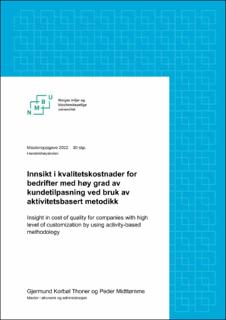| dc.contributor.advisor | Dahl, Øystein | |
| dc.contributor.advisor | Aune, Stig Alexander | |
| dc.contributor.author | Thoner, Gjermund Korbøl | |
| dc.contributor.author | Midttømme, Peder | |
| dc.date.accessioned | 2022-11-14T08:29:31Z | |
| dc.date.available | 2022-11-14T08:29:31Z | |
| dc.date.issued | 2022 | |
| dc.identifier.uri | https://hdl.handle.net/11250/3031573 | |
| dc.description.abstract | Teknologisk utvikling gir mulighet til mer effektiv produksjon og har forsterket kundens forventning til kvalitet for en lav pris. For å tilfredsstille kundens krav og holde seg konkurransedyktig, er bedrifter avhengige av å ha innsikt i kostnadene for å levere nåværende kvalitet. Færrest mulig avvik vil være et mål for bedrifter, men for bedrifter med høy grad av kundetilpasning kan null avvik være utfordrende å oppnå i praksis. Stor variasjon i ordre og lite rom for å standardisere produkter og prosesser medfører økt sannsynlighet for avvik.
Formålet med denne masteroppgaven har vært å undersøke hvordan aktivitetsbasert metodikk kan brukes for å gi økt innsikt i strukturen ved kvalitetskostnadene. I tillegg undersøke hvordan aktivitetsbasert metodikk, P-A-F- og Juran-modellen kan brukes for ressursoptimalisering for bedrifter med høy grad av kundetilpasning. For å belyse forskningsspørsmålene har vi gjennomført bedriftsbesøk hos fem bedrifter som leverer produkter med høy grad av kundetilpasning. Under besøkene gjennomførte vi semistrukturerte intervjuer for å få innsikt i prosessen til bedriftene. På bakgrunn av informasjonen fra intervjuene utarbeidet vi et kvantitativt aktivitetsskjema som ble benyttet for å kartlegge andel tid ansatte bruker på kvalitetsaktiviteter.
Masteroppgaven indikerer at aktivitetsbasert metodikk kan brukes til måling av kvalitetskostnader i bedrifter med høy grad av kundetilpasning. Ved å bruke aktivitetsbasert metodikk, P-A-F- og Juran-modellen gir det bedriftene en felles forståelse av kostnadsbildet, og en innsikt til å kunne optimalisere ressursbruk på et faglig grunnlag. Funnene viser at kvalitetskostnadene pr. årsverk er betydelige i forhold til omsetning og bedriftene er ubevisste på omfanget. Masteroppgaven viser også at aktivitetsbasert metodikk, P-A-F- og Juranmodellen har begrensinger ved at det er krevende å vurdere om fordelingen av kvalitetskostnader er gunstig. Likevel gir modellene innsikt i strukturen til kvalitetskostnader.
Masteroppgaven har praktiske implikasjoner for bedrifter med høy grad av kundetilpasning. Hvis bedrifter med høy grad av kundetilpasning bruker aktivitetsbasert metodikk, P-A-F- og Juran-modellen i kombinasjon, vil de få økt innsikt i kvalitetskostnader og et faglig grunnlag for ressursoptimalisering. | en_US |
| dc.description.abstract | Technological development provides the opportunity for more efficient production and has strengthened the customer's expectations for quality at a low price. To satisfy customer requirements and stay competitive, companies rely on having insight into the cost of delivering current quality. The fewest possible deviations will be a goal for companies, but for companies with a high degree of customer adaptation, zero deviations can be difficult to achieve in practice. Large variation in orders and little room for standardizing products and processes leads to an increased probability of deviations.
The purpose of this master's thesis has been to investigate how activity-based methodology can provide increased insight into the structure of quality costs. In addition, how activitybased methodology, the P-A-F and Juran model can be used for resource optimization for companies with a high degree of customer adaptation. We have conducted company visits to five companies that offer products with a high degree of customer adaptation. During the visits, we conducted semi-structured interviews to gain insight into the processes of the companies. Based on the information from the interviews, we prepared a quantitative activity form which map the proportion of time employees spend on quality activities.
Our thesis show that activity-based methodology can measure quality costs in companies with a high degree of customer adaptation. By using an activity-based methodology, P-A-F and Juran models, the companies gain a mutual understanding of the cost picture, and insight to be able to optimize resource use on a professional basis. The findings show that the quality costs of labour are significant concerning turnover, and the companies are unaware of the extent. The study also shows that activity-based methodology, the P-A-F and Juran model have their limitations in that it is difficult to say whether the distribution of quality costs is favourable, but the models provide insight into the structure of quality costs.
The study has implications for companies with a high degree of customer adaptation. If companies with a high degree of customer adaptation use activity-based methodology, the P-A-F and Juran model in combination, then they will experience an increased insight into quality costs and a professional basis for resource allocations. | en_US |
| dc.language.iso | nob | en_US |
| dc.publisher | Norwegian University of Life Sciences, Ås | en_US |
| dc.rights | Attribution-NonCommercial-NoDerivatives 4.0 Internasjonal | * |
| dc.rights.uri | http://creativecommons.org/licenses/by-nc-nd/4.0/deed.no | * |
| dc.title | Innsikt i kvalitetskostnader for bedrifter med høy grad av kundetilpasning ved bruk av aktivitetsbasert metodikk | en_US |
| dc.title.alternative | Insight in cost of quality for companies with high level of customization by using activity-based methodology | en_US |
| dc.type | Master thesis | en_US |
| dc.description.localcode | M-ØA | en_US |

